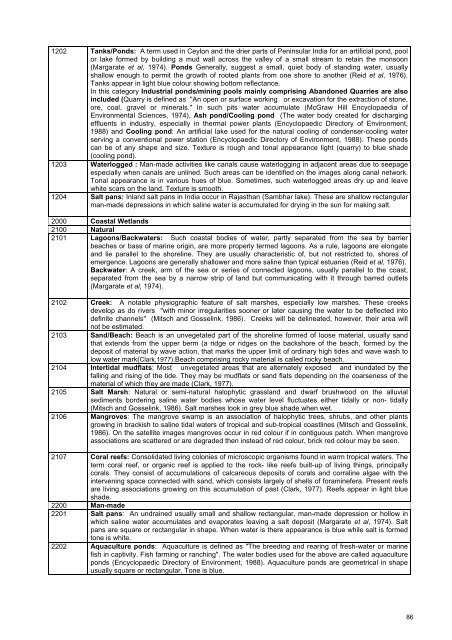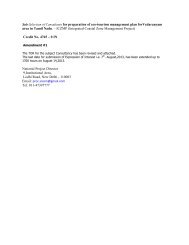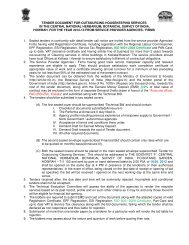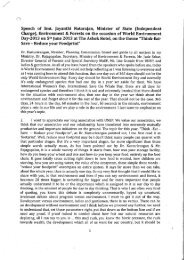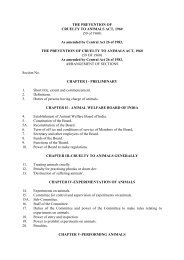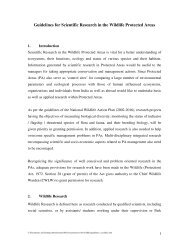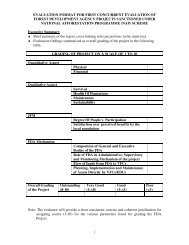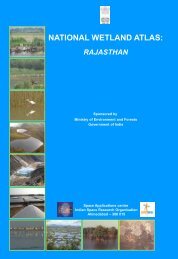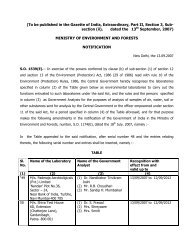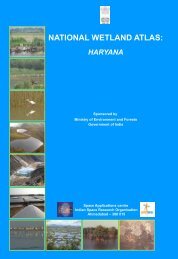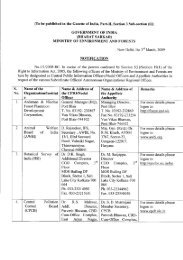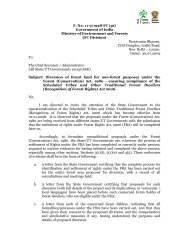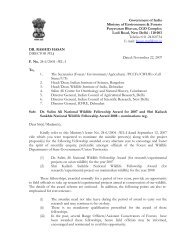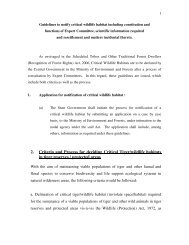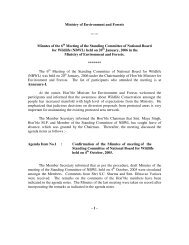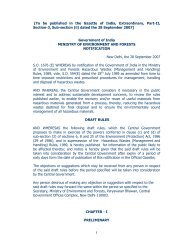Meghalaya - Ministry of Environment and Forests
Meghalaya - Ministry of Environment and Forests
Meghalaya - Ministry of Environment and Forests
- No tags were found...
Create successful ePaper yourself
Turn your PDF publications into a flip-book with our unique Google optimized e-Paper software.
1202 Tanks/Ponds: A term used in Ceylon <strong>and</strong> the drier parts <strong>of</strong> Peninsular India for an artificial pond, poolor lake formed by building a mud wall across the valley <strong>of</strong> a small stream to retain the monsoon(Margarate et al, 1974). Ponds Generally, suggest a small, quiet body <strong>of</strong> st<strong>and</strong>ing water, usuallyshallow enough to permit the growth <strong>of</strong> rooted plants from one shore to another (Reid et al, 1976).Tanks appear in light blue colour showing bottom reflectance.In this category Industrial ponds/mining pools mainly comprising Ab<strong>and</strong>oned Quarries are alsoincluded (Quarry is defined as "An open or surface working or excavation for the extraction <strong>of</strong> stone,ore, coal, gravel or minerals." In such pits water accumulate (McGraw Hill Encyclopaedia <strong>of</strong><strong>Environment</strong>al Sciences, 1974), Ash pond/Cooling pond (The water body created for dischargingeffluents in industry, especially in thermal power plants (Encyclopaedic Directory <strong>of</strong> <strong>Environment</strong>,1988) <strong>and</strong> Cooling pond: An artificial lake used for the natural cooling <strong>of</strong> condenser-cooling waterserving a conventional power station (Encyclopaedic Directory <strong>of</strong> <strong>Environment</strong>, 1988). These pondscan be <strong>of</strong> any shape <strong>and</strong> size. Texture is rough <strong>and</strong> tonal appearance light (quarry) to blue shade(cooling pond).1203 Waterlogged : Man-made activities like canals cause waterlogging in adjacent areas due to seepageespecially when canals are unlined. Such areas can be identified on the images along canal network.Tonal appearance is in various hues <strong>of</strong> blue. Sometimes, such waterlogged areas dry up <strong>and</strong> leavewhite scars on the l<strong>and</strong>. Texture is smooth.1204 Salt pans: Inl<strong>and</strong> salt pans in India occur in Rajasthan (Sambhar lake). These are shallow rectangularman-made depressions in which saline water is accumulated for drying in the sun for making salt.2000 Coastal Wetl<strong>and</strong>s2100 Natural2101 Lagoons/Backwaters: Such coastal bodies <strong>of</strong> water, partly separated from the sea by barrierbeaches or bass <strong>of</strong> marine origin, are more properly termed lagoons. As a rule, lagoons are elongate<strong>and</strong> lie parallel to the shoreline. They are usually characteristic <strong>of</strong>, but not restricted to, shores <strong>of</strong>emergence. Lagoons are generally shallower <strong>and</strong> more saline than typical estuaries (Reid et al, 1976).Backwater: A creek, arm <strong>of</strong> the sea or series <strong>of</strong> connected lagoons, usually parallel to the coast,separated from the sea by a narrow strip <strong>of</strong> l<strong>and</strong> but communicating with it through barred outlets(Margarate et al, 1974).2102 Creek: A notable physiographic feature <strong>of</strong> salt marshes, especially low marshes. These creeksdevelop as do rivers "with minor irregularities sooner or later causing the water to be deflected intodefinite channels" (Mitsch <strong>and</strong> Gosselink, 1986). Creeks will be delineated, however, their area willnot be estimated.2103 S<strong>and</strong>/Beach: Beach is an unvegetated part <strong>of</strong> the shoreline formed <strong>of</strong> loose material, usually s<strong>and</strong>that extends from the upper berm (a ridge or ridges on the backshore <strong>of</strong> the beach, formed by thedeposit <strong>of</strong> material by wave action, that marks the upper limit <strong>of</strong> ordinary high tides <strong>and</strong> wave wash tolow water mark(Clark,1977).Beach comprising rocky material is called rocky beach.2104 Intertidal mudflats: Most unvegetated areas that are alternately exposed <strong>and</strong> inundated by thefalling <strong>and</strong> rising <strong>of</strong> the tide. They may be mudflats or s<strong>and</strong> flats depending on the coarseness <strong>of</strong> thematerial <strong>of</strong> which they are made (Clark, 1977).2105 Salt Marsh: Natural or semi-natural halophytic grassl<strong>and</strong> <strong>and</strong> dwarf brushwood on the alluvialsediments bordering saline water bodies whose water level fluctuates either tidally or non- tidally(Mitsch <strong>and</strong> Gosselink, 1986). Salt marshes look in grey blue shade when wet.2106 Mangroves: The mangrove swamp is an association <strong>of</strong> halophytic trees, shrubs, <strong>and</strong> other plantsgrowing in brackish to saline tidal waters <strong>of</strong> tropical <strong>and</strong> sub-tropical coastlines (Mitsch <strong>and</strong> Gosselink,1986). On the satellite images mangroves occur in red colour if in contiguous patch. When mangroveassociations are scattered or are degraded then instead <strong>of</strong> red colour, brick red colour may be seen.2107 Coral reefs: Consolidated living colonies <strong>of</strong> microscopic organisms found in warm tropical waters. Theterm coral reef, or organic reef is applied to the rock- like reefs built-up <strong>of</strong> living things, principallycorals. They consist <strong>of</strong> accumulations <strong>of</strong> calcareous deposits <strong>of</strong> corals <strong>and</strong> corraline algae with theintervening space connected with s<strong>and</strong>, which consists largely <strong>of</strong> shells <strong>of</strong> foraminefera. Present reefsare living associations growing on this accumulation <strong>of</strong> past (Clark, 1977). Reefs appear in light blueshade.2200 Man-made2201 Salt pans: An undrained usually small <strong>and</strong> shallow rectangular, man-made depression or hollow inwhich saline water accumulates <strong>and</strong> evaporates leaving a salt deposit (Margarate et al, 1974). Saltpans are square or rectangular in shape. When water is there appearance is blue while salt is formedtone is white.2202 Aquaculture ponds: Aquaculture is defined as "The breeding <strong>and</strong> rearing <strong>of</strong> fresh-water or marinefish in captivity. Fish farming or ranching". The water bodies used for the above are called aquacultureponds (Encyclopaedic Directory <strong>of</strong> <strong>Environment</strong>, 1988). Aquaculture ponds are geometrical in shapeusually square or rectangular. Tone is blue.86


